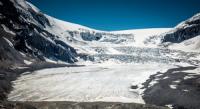-
With more superstorms predicted, there’s a dream project to keep New York above water
Five years ago, on 29 October 2012, the coasts of New York and New Jersey were devastated by a rare late-October superstorm. Superstorm Sandy killed seventy-two people in the United States and caused more than $70 billion in damage. Over the next thirty years, floods of 7.4 feet or more, which used to occur in the New York area once every 500 years and are now happening every 25, could strike as frequently as every five years. Scientists say that sea-level rise caused by climate change is the biggest factor. One big idea to prevent massive destruction from the next, inevitable superstorm: A constellation of giant underwater gates which would rise in New York Harbor and beyond when disaster looms.
-
-
Why were California’s wine country fires so destructive?

As of late October more than a dozen wildfires north of San Francisco had killed more than 40 people, burned approximately 160,000 acres and destroyed more than 7,000 structures. The path of the destructive 2017 Tubbs fire in Napa and Sonoma counties mirrors that of the Hanley fire of 1964. Strikingly, though, no lives were lost during the Hanley fire and only 29 structures were destroyed. Why did these two fires, 50 years apart, burn on the same general landscape, under similar extreme winds, with such different human impacts? Fire scientists will study these events intensively to parse out the relative importance of various factors. But it is clear that two factors probably were major contributors: wind and population growth. Drought and warmer climates have made wildfires a year-round hazard in California. Expanded urban development, in tandem with hot winds, seems to be the primary reason for the destruction this year.
-
-
Mountain glaciers shrinking across the West

A new, satellite-produced, high-resolution map of roughly 1,200 mountain glaciers in the lower 48 states shows steady, and worrisome, loss of snow and ice cover. Tracking the status of so many glaciers will allow scientists to further explore patterns in the changes of snow and ice coverage over time, which will help pinpoint the causes — from changes in temperature and precipitation to slope angle and elevation – and also help improve water management in areas dependent on meltwater.
-
-
Future NYC flooding will be caused by sea-level rise, not stronger storm surge
Rising sea levels caused by a warming climate threaten greater future storm damage to New York City, but the paths of stronger future storms may shift offshore, changing the coastal risk for the city, according to a team of climate scientists. Future changes in sea level and storms would be smaller if actions were taken to slow climate change, such as the Paris Accord’s goal of limiting warming to 3.6 degrees Fahrenheit.
-
-
Globe had 2nd warmest year to date, 4th warmest September on record
The average global temperature set in September 2017 was 1.40 degrees F above the 20th-century average of 59.0 degrees. This average temperature was the fourth highest for September in the 1880-2017 record. This marked the 41st consecutive September and the 393rd consecutive month with temperatures above the 20th-century average. The year-to-date average temperature was 1.57 degrees F above the 20th-century average of 57.5 degrees. Arctic and Antarctic sea ice coverage remains small.
-
-
Warming seas could lead to 70 percent increase in hurricane-related financial loss
If oceans warm at a rate predicted by the Intergovernmental Panel on Climate Change, the UN-sponsored group that assesses climate change research and issues periodic reports, expected financial losses caused by hurricanes could increase more than 70 percent by 2100, according to researchers. The finding is based on the panel’s most severe potential climate change scenario – and resulting increased sea surface temperature – and is predicted at an 80 percent confidence level. The model drew on hurricane data for the last 150 years gathered by NOAA.
-
-
Climate action window could close as early as 2023
As the Trump administration repeals the U.S. Clean Power Plan, a new study underscores the urgency of reducing greenhouse gas emissions—from both environmental and economic perspectives. For the U.S. most energy-hungry sectors—automotive and electricity—the study identifies timetables for action, after which the researchers say it will be too late to stave off a climate tipping point. And the longer the nation waits, the more expensive it will be to move to cleaner technologies in those sectors—a finding that runs contrary to conventional economic thought because prices of solar, wind and battery technologies are rapidly falling, the study’s authors say.
-
-
Flights worldwide face increased risk of severe turbulence owing to climate change
Flights all around the world could be encountering lots more turbulence in the future, according to the first ever global projections of in-flight bumpiness. A new study has calculated that climate change will significantly increase the amount of severe turbulence worldwide by 2050–2080. Severe turbulence involves forces stronger than gravity, and is strong enough to throw people and luggage around an aircraft cabin.
-
-
Administration’s decision to rescind 2015 water rule based on flawed analysis: Experts
New evidence suggests that the Trump administration’s proposal to rescind the 2015 Waters of the United States (WOTUS) rule that would limit the scope of the Clean Water Act inappropriately overlooks wetlands-related values. The differences between the two analyses led to an almost 90 percent drop in quantified benefits from the 2015 to the 2017 analysis.
-
-
Limiting warming to 1.5°C still possible
Significant emission reductions are required if we are to achieve one of the key goals of the Paris Agreement, and limit the increase in global average temperatures to 1.5°C; scientists say. A new study, investigating the geophysical likelihood of limiting global warming to “well below 2°C above pre-industrial levels and pursuing efforts to limit the temperature increase to 1.5°C,” concluded L limiting the increase in global average temperatures above pre-industrial levels to 1.5°C, the goal of the Paris Agreement on Climate Change, is not yet geophysically impossible, but likely requires more ambitious emission reductions than those pledged so far.
-
-
1-in-20 chance of warming causing catastrophic, or even existential, damage by 2050
A new study evaluating models of future climate scenarios has led to the creation of the new risk categories “catastrophic” and “unknown” to characterize the range of threats posed by rapid global warming. Researchers propose that unknown risks imply existential threats to the survival of humanity. The researchers identify a one-in-20 chance of temperature increase causing catastrophic damage or worse by 2050.
-
-
Rethinking where/whether to rebuild after Hurricanes Irma, Harvey
Though our natural instinct is to put everything back exactly where it was before a disaster, Mark Abkowitz, professor of civil and environmental engineering and director of the Vanderbilt Center for Environmental Management Studies said people need to seriously rethink where and how to rebuild. “We’re talking hurricanes now, but it could be inland flooding, tornadoes, drought, wildfires, earthquakes. The question really comes up: If we had things the way they were and they suffered the level of catastrophic impact that they did, what’s the reasoning behind putting it back exactly the way it was before?” asks Abkowitz.
-
-
Houston's “flood czar” says Harvey has brought the city to a decision point on flood control
In the wake of Hurricane Harvey’s record floods, the city of Houston is poised to receive billions — maybe even tens of billions — of recovery dollars in the coming years that may cover significant improvements to the city’s woefully inadequate drainage system as well as other projects to reduce flooding. Stephen Costello, Houston’s chief resilience officer, expects to play a big role in how Houston spends it Hurricane Harvey recovery dollars.
-
-
Designing a post-Harvey Houston for the future
Being honest about the extent and urgency of the Houston-Galveston region’s flooding problem will not harm the community but will form the basis for recovery, according to a paper by an engineering and environmental expert. “Denying fundamental truths and moving forward with business as usual will be the economic death knell for the Houston region,” Rice University’s Jim Blackburn wrote in a paper highlighting fifteen policies and actions that are meant to initiate a conversation about designing a Houston for the future. “And make no mistake about it — how we respond to this horrible reality will determine the economic future of our region.”
-
-
Are catastrophic disasters striking more often?
Two major storms — Hurricane Harvey and Hurricane Irma – in as many weeks raise this question: Is the number of major natural disasters striking the United States actually increasing, or does the media’s natural tendency to overhype conflict only make it seem so? Since 1980 there have been 212 disasters, which NOAA calculates resulted in over $1.2 trillion in damage. My analysis of the NOAA data shows that the number of billion-dollar disasters has indeed been increasing over time. A typical year in the 1980s experienced on average 2.7 such disasters in the U.S. In the 1990s and 2000s, that average had climbed to 4.6 and 5.4 a year, respectively. Since then, the frequency of costly disasters has soared. In this decade so far, each year has seen an average of 10.5 disasters. The scale of this increase amounts to one additional billion-dollar disaster every four years.
-
- All
- Regional
- Water
- Biometrics
- Borders/Immig
- Business
- Cybersecurity
- Detection
- Disasters
- Government
- Infrastructure
- International
- Public health
- Public Safety
- Communication interoperabillity
- Emergency services
- Emergency medical services
- Fire
- First response
- IEDs
- Law Enforcement
- Law Enforcement Technology
- Military technology
- Nonlethal weapons
- Nuclear weapons
- Personal protection equipment
- Police
- Notification /alert systems
- Situational awareness
- Weapons systems
- Sci-Tech
- Sector Reports
- Surveillance
- Transportation
Advertising & Marketing: advertise@newswirepubs.com
Editorial: editor@newswirepubs.com
General: info@newswirepubs.com
2010-2011 © News Wire Publications, LLC News Wire Publications, LLC
220 Old Country Road | Suite 200 | Mineola | New York | 11501
Permissions and Policies
Editorial: editor@newswirepubs.com
General: info@newswirepubs.com
2010-2011 © News Wire Publications, LLC News Wire Publications, LLC
220 Old Country Road | Suite 200 | Mineola | New York | 11501
Permissions and Policies
